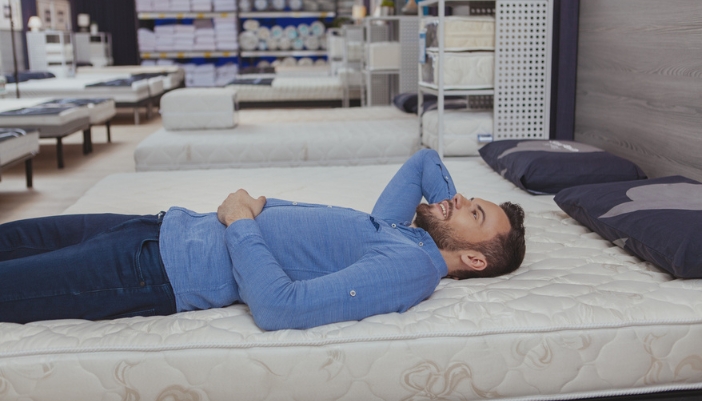You know that feeling when you wake up, and your back's already mad at you? Not because you ran a marathon or slept on a pile of rocks—but because your bed just isn't cutting it. That mysterious combo of too-soft-but-somehow-too-firm has a way of sneaking up on you and ruining your morning.
Truth is, choosing between a firm or soft mattress sounds simple—until you're actually doing it. Your back wants one thing, your hips want another, and your brain's just tired of the whole decision.
Good news? Our experts at Energy Center Appliance are here to help you figure it out—without the guesswork, gimmicks, or weird mattress jargon.

What "Firm" and "Soft" Actually Mean
Mattress shopping can feel like you're learning a new language—and "firm" and "soft" are two words that get lost in translation fast. Most of us think we know what they mean… until we actually lie down on one, and our back says, "Nope."
Firmness refers to how a mattress feels when you first lie down. It's the immediate surface feel—whether it has more give (soft) or pushback (firm).
- A soft mattress (1–4 on the firmness scale) tends to let you sink in a bit, with more cushion and pressure relief around areas like hips and shoulders.
- A firm mattress (7–10) feels more solid and supportive on the surface, keeping your body more lifted and aligned.
Here's what firmness really comes down to:
- The firmness scale runs from 1 to 10, but it's not standardized across all brands—so a "medium-firm" can vary depending on where you're shopping.
- Body weight affects how firm or soft a mattress feels. Heavier sleepers may sink deeper into a mattress and experience it as softer, while lighter sleepers might not compress the layers enough to get that same feel.
- Materials matter, too. Memory foam usually feels softer and more contouring, while innerspring or latex might feel firmer and more buoyant.
Pro Tip:
The hand-press test is a good start, but the real test is how your whole body feels. Try lying on a mattress for at least 10–15 minutes in your usual sleep position to get a true sense of the comfort level.

What Your Back Needs: How Firmness Affects Spinal Alignment
Here's the thing about your back—it has opinions. Loud ones. And if your mattress doesn't keep your spine in a healthy, neutral position while you sleep, your back will let you know about it in the morning.
The goal? Spinal alignment. That means your head, shoulders, hips, and spine should all stay in a straight, natural line—no sagging, no over-arching. The right mattress firmness helps keep that alignment in check:
- Too soft = too much sink. Your heavier body parts (like hips and shoulders) can dip down, throwing your spine out of line and putting pressure on joints.
- Too firm = not enough give. A very firm mattress may push your body upward, especially around the shoulders and hips, which can cause tension and poor circulation.
- The "just right" zone keeps you supported, not stiff. The right firmness level lets your body relax into the mattress while keeping your spine aligned and supported.
- Spinal misalignment can sneak up on you. You might not notice it at first, but over time, it can lead to morning stiffness, lower back pain, and restless sleep.
Matching Firmness to Sleep Position
Not all sleepers are created equal. Whether you curl up like a cat or flop face-down like a starfish, your go-to sleep position plays a big role in how firm or soft your mattress should be.
- Side sleepers: You'll likely want a medium to soft mattress. It cushions pressure points like your shoulders and hips while still keeping your spine aligned. Too firm, and you might wake up with numb arms or sore joints.
- Back sleepers: A medium-firm mattress usually does the trick. It supports your lower back while letting your shoulders and hips settle in just enough to keep everything aligned.
- Stomach sleepers: You'll need something on the firmer side. This keeps your hips from sinking too low, which can lead to serious lower back strain.
- Combination sleepers: If you shift positions during the night, aim for a medium-firm feel that adapts well across the board.
Pro Tip:
When in doubt, medium-firm is usually the safest bet. It's the most versatile comfort level and works for a wide range of sleep positions and body types.

Why Materials Matter More Than You Think
Here's something mattress labels don't always tell you: two beds with the same firmness rating can feel completely different depending on what they're made of. The materials inside the mattress affect everything from contouring to bounce to temperature—and yes, even how firm or soft it feels when you lie down.
- Memory foam: Known for its slow sink and contouring feel. It can feel softer than its rating because it molds to your body and relieves pressure points. Great for side sleepers and folks with joint pain.
- Innerspring: Offers more bounce and airflow, and often feels firmer. Good for back and stomach sleepers who want more support and less "hug."
- Hybrid: Combines coils with foam or latex layers. It balances support and comfort, making it a solid pick for couples or combo sleepers.
- Latex: Naturally firmer and bouncier than memory foam, with a more responsive feel. Also tends to sleep cooler. It's a great option if you want pressure relief without the deep sink.
- Pillow tops or plush layers: These can make a mattress feel softer on top, even if the core is firm. Good for those who like a cushioned feel without sacrificing support.
Final Tips for Finding Your Just-Right Comfort Zone
Still not sure if you need soft, firm, or somewhere in between? You're not alone. Comfort level can be surprisingly personal, but there are a few tried-and-true ways to narrow it down.
- Start with your sleep position. This is usually the best starting point for figuring out your ideal firmness range (see earlier section for the cheat sheet).
- Pay attention to pressure points. If your hips, shoulders, or back feel sore in the morning, your mattress might be too firm—or too soft to support you properly.
- If you're stuck between two firmness levels, go with medium-firm. It's the most universally comfortable option and works well for couples or combo sleepers.
- Consider a mattress topper. Not ready to commit to a whole new bed? A topper can adjust the feel of your current mattress without a big investment.
- Don't sleep on adjustability. Some mattresses offer dual-firmness or adjustable comfort zones—perfect if you and your partner have wildly different preferences.
Pro Tip:
Your comfort needs could change over time—so if you used to love a firm mattress but now wake up stiff, it might be time to reassess. Bodies change, and your mattress should keep up.

Let's Put This to Bed
Picking the right mattress comfort level isn't about impressing your spine—it's about keeping it happy, night after night. And when you land on the right one? Total game-changer. No more stiff mornings. No more bedtime dread. Just sleep that actually helps you feel better the next day.
Still not sure what your back is asking for? Swing by Energy Center Appliance and chat with our experts. We're here to answer your questions, help you test the options, and match you with a mattress that makes sense for you. Stop in, say hey, and let's get you sleeping better. Your back will thank you.